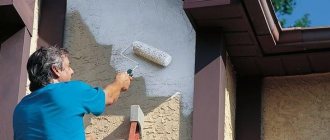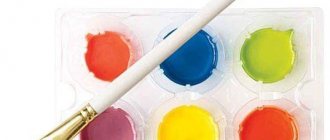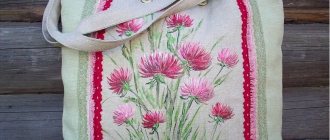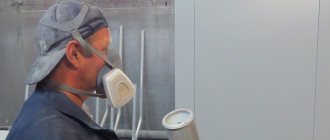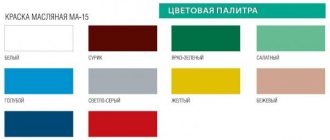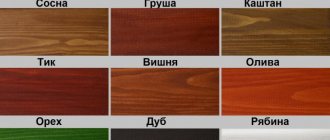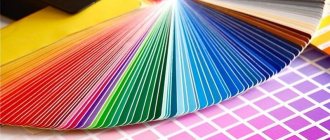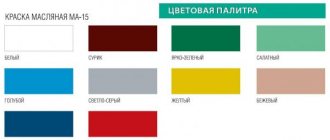General properties
Acrylic enamel for metal has a water-dispersed base made from polymers. The final composition depends on the type of mixture. One of the important properties is resistance to wet environments. Therefore, the composition can be used in bathrooms and kitchens where there is an increased level of moisture.
Acrylic enamel for metal has a water-dispersed base made from polymers.
Advantages
When compared with other types of coloring agents, acrylic is in great demand for its excellent qualities:
- resistant to sunlight;
- does not react to moisture, steam;
- have no pungent odor and are characterized by low toxicity. Therefore, it does not cause irritation to the upper respiratory tract. It is allowed not to use personal protective equipment (as when painting with nitro paint);
- does not require the use of special tools when painting. You can use brushes, rollers, spray guns and other handy tools. It is most economical to apply to the surface using a spray gun, especially when you need to paint a large area;
- after the work is done, the tools used can be easily washed with tap water;
- Sun rays, air and moisture have a negative effect on conventional paints, causing the top layer to harden, thin and crack. Acrylic does not have a similar effect;
- does not succumb to yellowing and does not lose its gloss;
- non-toxic and does not cause fire (rooms with gas and oil products at gas stations can be painted);
- after drying, the film becomes elastic. Elasticity protects acrylic from damage caused by sudden temperature changes.
Peculiarities
Acrylic paint for metals is the market leader for this type of surface. Its cost is higher when compared with analogues. But it has a good level of adhesion to a metal base.
Compared to analogues, this type of paintwork material has a long service life. The composition is durable and is able to retain its properties even under difficult operating conditions.
When the temperature changes, the already dried composition does not spread. The layer remains smooth, maintaining its decorative characteristics.
The composition is durable and is able to retain its properties even under difficult operating conditions.
Creating decor using aerosol
Decorating metal surfaces should be started only after the final selection of the application method and type of material. To make the space at home more attractive, comfortable and memorable, many resort to the services of professional decorators. However, you can make a room unique on your own - all you need is imagination and decorative paint. Aerosol products are characterized by economical consumption and ease of spraying.
With the help of an aerosol you can bring to life the most extraordinary design solutions: create smooth color transitions, geometric patterns and abstract designs. Paint sprays are great for finishing metals and various uneven surfaces. Has your favorite item become unusable? Use aerosol sprays and give it a “second life”!
Interestingly, acrylic paint in aerosols is also used for tuning vehicles. A decorative layer of gold or silver acrylic mixture will not only improve the appearance of the car, but also increase the protective properties of the surface - which is important under constant mechanical loads.
On video: review and application of aerosol decorative paint.
Specifications
Water-based paint for metal can be used not only for interior decoration, but also exterior. It is safe for human health and environmentally friendly. Its characteristics and properties allow it to be used in difficult conditions.
Such coatings can withstand the influence of direct sunlight, high humidity, and various weather conditions. The coating is also vapor-tight and wear-resistant. Suitable for cladding not only metal bases, but also wood and concrete.
The basis of the composition is water. When the layer is applied, it evaporates from the surface. All that remains is a smooth, durable film. Due to the absence of a strong odor, acrylic paint is excellent for use at home.
In addition to a standard brush, you can use a roller or a special spray gun to coat the metal. In the first case, this improves the quality of painting. The spray gun uses paintwork materials economically, which allows you to reduce consumption.
Such coatings can withstand the influence of direct sunlight, high humidity, and various weather conditions.
How to paint a wooden model metallic silver
A short photo master class on how to paint the “Eiffel Tower” construction model using aerosol primer, Vernen Shabby paints and spectacular metallic paint “Silver”.
The recommendations are suitable for painting any other surfaces. In principle, primer is not needed for Shabby paint, since it has the same properties as chalk (only based on milk casein with porcelain particles). I used aerosol primer in order to paint the model in places that were difficult to reach with a brush.
So, our thin plywood blank is the Eiffel Tower construction model. 1. I recommend sanding any piece of wood or plywood before starting work. If necessary, we eliminate chips and defects using putty (you can buy decorative mastic for this).
2. Next, paint the model inside and outside with any black aerosol primer. Follow the instructions on the can for drying time and spraying. This soil has a rather pungent odor, so we work in a well-ventilated area or outdoors. It would be possible to immediately paint the workpiece without primer with a brush using Vernen paint Shabby Fog, but it would be difficult to paint such a model with a brush.
3. Next, we rather casually paint the tower model with a brush using Shabby “Fog” paint, so that our tower looks a little vintage and shabby. I chose a gray paint shade as it will serve as a base for creating a gray-silver metallic finish on the surface of the tower using Vernen Silver paint. If you paint “Silver” immediately over black, you will get a slightly different effect - a black surface with a silver tint (see photo on the right). Without the gray base we would have had to apply many, many coats of Silver to cover up the black.
4. After the gray paint has dried, apply the spectacular Vernensky “Silver” paint with a brush and dry the surface of the work. Better in a natural way. The paint dries quite quickly.
This is what we came up with pretty quickly! The effect of a gray metal surface with a silver shine.
By the way, my daughter and I painted this rocket, namely its silver body, in exactly the same way. The cardboard sheet was bright purple (like the stripes). First we applied two coats of gray Vernensky Shabby “Fog” paint, then one coat of Vernensky “Silver” paint.
If you found the article useful, please like it.
Sources: https://www.stroimet.net/2014/12/03/akrilovaya_kraska_dlya_metalla.html https://www.livemaster.ru/topic/2402353-kak-okrasit-derevyannuyu-model-v-serebristyj-metallik https: //kraskacentr.ru/kraski/vidy-krasok/akrilovaja-kraska.html
Advantages and disadvantages
Any facing material has advantages and disadvantages. They must be taken into account in order to prevent possible problems and select the most suitable coating for specific operating conditions.
Among the advantages of acrylic mixtures it is worth noting:
- Wear resistance and durability. If improperly processed and cladding, metal bases quickly deteriorate and become covered with rust. The acrylic composition allows you to protect the surface from corrosion for up to 10 years;
- No regular updates required. The paint can retain its original appearance for many years;
- The white coating does not turn yellow over time and will not fade;
- Ability to withstand difficult operating conditions. This applies to temperature changes, high humidity levels, and constant exposure to sunlight. The factors described do not impair the performance or appearance of the paint. Also, when used as external cladding, the coating withstands snow, rain and other weather conditions;
- Safety. The composition does not contain toxic substances. Therefore, it can not only be used for painting pipes and gas storage facilities, but also any room in the house. No pungent smell. Harmless in contact with skin;
- Withstands high temperatures. Able to retain their properties even at 120 degrees. Some types contain special silicate resins that allow them to withstand higher temperatures.
The acrylic composition allows you to protect the surface from corrosion for up to 10 years.
In addition to the positive aspects, acrylic compositions have disadvantages. Among them:
- Drying time. Manufacturers claim that the coating dries quickly. However, it will take up to a month for the paint to dry completely and form a high-quality layer. This is how long the formed film will remain vulnerable to various influences and damage;
- Limited palette of shades. Other types of coatings have a wider selection of colors. But if you managed to choose the right tone, then this minus can be eliminated;
- Price. It was noted that compared to analogues, the price of this paint is higher.
It will take up to a month for the paint to dry completely and form a high-quality layer.
Flaws
Acrylic coating has some disadvantages. But they are easy to deal with. Initially, the mixture dries very quickly, but the final formation of a layer of acrylic paint on metal and the formation of a durable film takes place within 30 days. During this period, the enamel dries completely and hardens “tightly”. For a month after application, while the paint is still pliable, it must be protected from contamination and any deformation.
The second point that can be attributed to disadvantages is decorative properties. Many paints have a brighter, richer color scheme. Acrylic mixtures have more muted tones. But for painting roofs and fences this is not so important, so color properties can only be classified as disadvantages only conditionally.
The cost of acrylic coating is much more expensive than conventional compositions. But this can only be classified as a disadvantage only conditionally, since the mixtures have great durability. But acrylic compositions do not tolerate severe frosts so well.
What to consider when choosing
When choosing a composition, you need to focus on the conditions in which it will be used. What matters is the external or internal finish, the conditions under which the composition is planned to be used. Next, you need to find out the area to be painted and the number of planned layers. The choice of a suitable tool for applying the composition and the amount of paint depend on this. It is recommended to purchase material in reserve.
You should choose paintwork materials from proven manufacturers who have managed to establish themselves on the positive side in the market. Be sure to check the expiration date before purchasing. It is recommended to discard the material if it is about to deteriorate.
When choosing a composition, you need to focus on the conditions in which it will be used.
Alkyd paints.
Alkyd enamels for metal are divided into 2 types:
- Oil compositions. The basis of oil compositions is drying oil, which is extracted from natural oils. Drying oil-based paints and varnishes are suitable only for interior work. If oil paint is used for exterior work, then under the influence of the sun it loses its color and cracks. In addition, it is not capable of high-quality protection against corrosion.
- Enamels. Metal enamel provides products with an attractive appearance and protects against corrosive changes. Such anti-corrosion enamels for metal include “ KO-198”, “ PF 115 ” GOST 6465 76, “EP-1155”.
Technology of application to a metal surface
The metal surface is cleaned of traces of corrosion using a special brush or rust converter. You can refuse to use a primer. But it is necessary to clean the base from traces of grease and dust. Additionally, everything is dried.
After opening the paint, its top layer is drained and then stirred. The temperature when applying paintwork materials should be from +5 degrees. The surface begins to be coated with paint using a suitable tool. Both a standard brush and a spray gun or roller will do. For metal, about 2-3 layers are suitable.
Each subsequent layer must be applied only after the previous one has dried. When the paintwork is completely applied, you just have to wait until it dries completely.
Each subsequent layer must be applied only after the previous one has dried.
Acrylic paint has many advantages and is suitable for treating metal surfaces. It's convenient to work with her. It is durable and resistant. Able to withstand difficult operating conditions. The main thing is to take into account some features of the composition before use. Then the coating will be of high quality and durable.
Details
Advantages
Acrylic paints and varnishes began to be used relatively recently, but in record time they were able to gain popularity due to their unique properties. The mixtures are quite durable, and acrylic paints for metal processing remain on the surface without corrosion for 8 years. For many years, the coating will retain its protective qualities without requiring updates. Ultraviolet solar radiation and oxygen, reaching the top layer of simple paints and varnishes, also cause it to harden. As a result, it becomes more fragile, thinner and begins to crack. This does not happen with acrylic paints.
Painting metal with acrylic paint is the best solution. The white coating will not turn yellow and will not lose its gloss. This became possible due to the polymer emulsion, which plays the role of a binder, will not react to oxygen, and is not yet susceptible to oxidation. Despite the fact that the high-strength film on the treated surface takes quite a long time to form, the mixture dries quickly and after that it will not be affected by bad weather. For many coatings, metal corrosion has become a problem. The fact is that it begins to react quite quickly to condensation and moisture. As a result, a red, loose coating forms on it, which is called rust. Acrylic paints for metal (created for outdoor use) contain anti-corrosion substances. It begins to react with rust, and then forms an inert composition.
The film, which appears after 100% drying, has high elasticity. As a result, a metal surface painted with acrylic enamel is able to withstand all temperature changes. In this case, compression and stretching of the metal begins to occur, which due to the elasticity of the film, the paint does not fully affect it. In addition to all the advantages described above, acrylic paint for metal does not contain toxic or fire hazardous substances. For this reason, the coating is ideal for painting oil and gas storage facilities, as well as gas stations. Paints for metal processing (for outdoor work) can withstand temperatures up to +125 degrees. Special compositions are made from silicone resin, and epoxy-bitumen types of coatings are also used. Silicone resin compositions can withstand temperatures up to +600 degrees, and bitumen ones only up to +400 degrees.
Flaws
Acrylic coatings have certain disadvantages, but they can be dealt with fairly easily. Initially, the mixture dries out very quickly, but the complete formation of a layer of acrylic paints for treating metal surfaces and obtaining a stable film will occur within 1 month. During this period, the enamel dries out completely and “tightly” hardens. For 1 month after application, while the paint layer is pliable, it should be protected from all types of deformation and contamination. Another point that can be attributed to the minus is the decorative qualities, and most paints have a richer and brighter range of colors. Acrylic products have more muted tones, but for painting fences and roofs this is not so important, and therefore this can only be considered a disadvantage of color properties. The price of acrylic coatings is much more expensive than the most common paints and varnishes. But this can only be conditionally classified as a disadvantage, because the mixtures are durable. But acrylic compositions do not tolerate severe frost so well.
Application method
Before starting the painting process, it is worth preparing the surface to be treated. If there is rust on the product, it should definitely be removed. This can be easily done with a wire brush. You can also use a rust converter to remove corrosion. Before painting, metal surfaces must be cleaned of dirt, grease, dried and primed. In this case, the composition will lie evenly, and its consumption will be greatly reduced. The preparatory stage of the treated surface is a very important factor that will increase the durability of the coating. Before fully painting the fence, parts and roof or other metal products, you should first treat the individual “recessed” or protruding fragments with enamel. This can be done with a small can of paint or a brush.
Water-based acrylic metal paint should be mixed before use. It can be applied with any convenient tools. But they all have certain features. For example, a brush can leave streaks, and a roller can create shagreen, although in the second case the coloring will be of better quality. It will be quite economical and effective to spray the paint composition through a spray bottle. This may require a thinner consistency, but dilution with water is carried out strictly according to the instructions. All necessary proportions must be observed.
Ideally, a layer of paint and varnish material should be applied 2 times. If the layer turns out to be thicker, then this violates the film elasticity. The interval between two applications of the composition should be 1-2 hours. Since this paint does not have rich, bright colors, they can be obtained by adding specialized pigments. It is difficult to achieve such a color, and therefore it is better to make the required amount of paint with a reserve. The best option would be computer tinting, and in this case it will be quite easy to repeat the desired color.
If you plan to use acrylic paint on metal for interior work, and the color should have a beautiful glossy color, then you can replace it with acrylic varnish with polishing. If you wish, you can initially opt for a matte finish. Since the material is resistant to high temperatures, the coating can be used to apply paint to heating radiators. A competent choice of composition for processing metal products makes it possible to get rid of corrosion for many years. The minimum effective life of acrylic paint and varnish compositions is 7 years, but such coatings can last much longer if the product has been previously cleaned of rust. Acrylic paints on metal for interior work can be used not only for fences and roofs, but acrylic paints are also actively used for facade work and interior metal finishing work.
Alkyd or acrylic primer: which one to choose?
15.05.2014
Surface preparation before finishing with any materials is extremely important. Priming helps save you money, significantly improve the quality of your repair and extend its service life. How to choose the right building materials and perform the work?
The primer is used for all types of substrates: metal, wood, concrete, brick, plaster, drywall, putty. Its main purpose is to ensure a strong “grip” of finishing materials, be it wallpaper, paint, varnish or tile, with the base. Paint and varnish technologies do not stand still; now you can find a primer that will protect wood from rotting and fungus formation, metal from corrosion, plaster or putty imparts special strength due to deep penetration or even color.
The choice of primer should be based on the type of substrate and the properties you want to give it. Today, a large assortment of acrylic and alkyd materials is presented on store shelves.
Tips and recommendations for use
Depending on the surface on which the enamel will be applied and the composition of the paint, it will depend on what choice to make. To protect wooden products from mold and rotting processes, water-based, dispersion and universal enamel is used.
Protective components against corrosion are added to the enamel composition for painting metal structures. Fire-resistant, acrylic-urethane mixture is suitable in this case.
It is recommended to buy enamel, which can be wiped with a damp cloth, if you need to add color to the floors. In addition, such paints dry quickly, do not attract dust, and retain their shine for a long time.
As a rule, plastic objects can also be painted using acrylic paints - however, a primer is first applied to the object. Heat-resistant products are intended for finishing radiators. It can also be used to paint brick, concrete and metal structures.
Water-dispersed enamel, which contains antiseptic components, is relevant in bathrooms and kitchens, since the paintwork can be easily wiped off, and besides, it is not afraid of moisture.
How to choose paint for metal.
The choice of paint depends on whether the product being painted will be exposed to high temperatures and in what environment the product will be used. Oil and alkyd paints can withstand temperatures from 80 to 120 °C. The most heat-resistant are polyurethane coatings, epoxy-bitumen based on silicone resins. These paints include: “KO-868”, “Certacor Zn”, “KO 8101”, “Ekotsin”, “Certa +900°C”. So, when choosing paint, it makes sense to consult with specialists involved in paint sales.
Hammer paint for metal.
Hammer paint consists of epoxy, alkyd and acrylic bases, with the addition of fine glass and aluminum powder. The name “hammer” was given due to the similarity of the final coating, which is reminiscent of “hand hammer embossing”: rough to the touch with a pronounced metallic sheen. The paint is resistant to moisture, vibration and temperature changes. Hammer enamel has a wide range of colors, and its texture can be glossy or matte. Applying two coats of paint replaces the primer and final coat. Such paints include “EP-1323 ME” (quick-drying) , “TSERTA-PLAST”.

